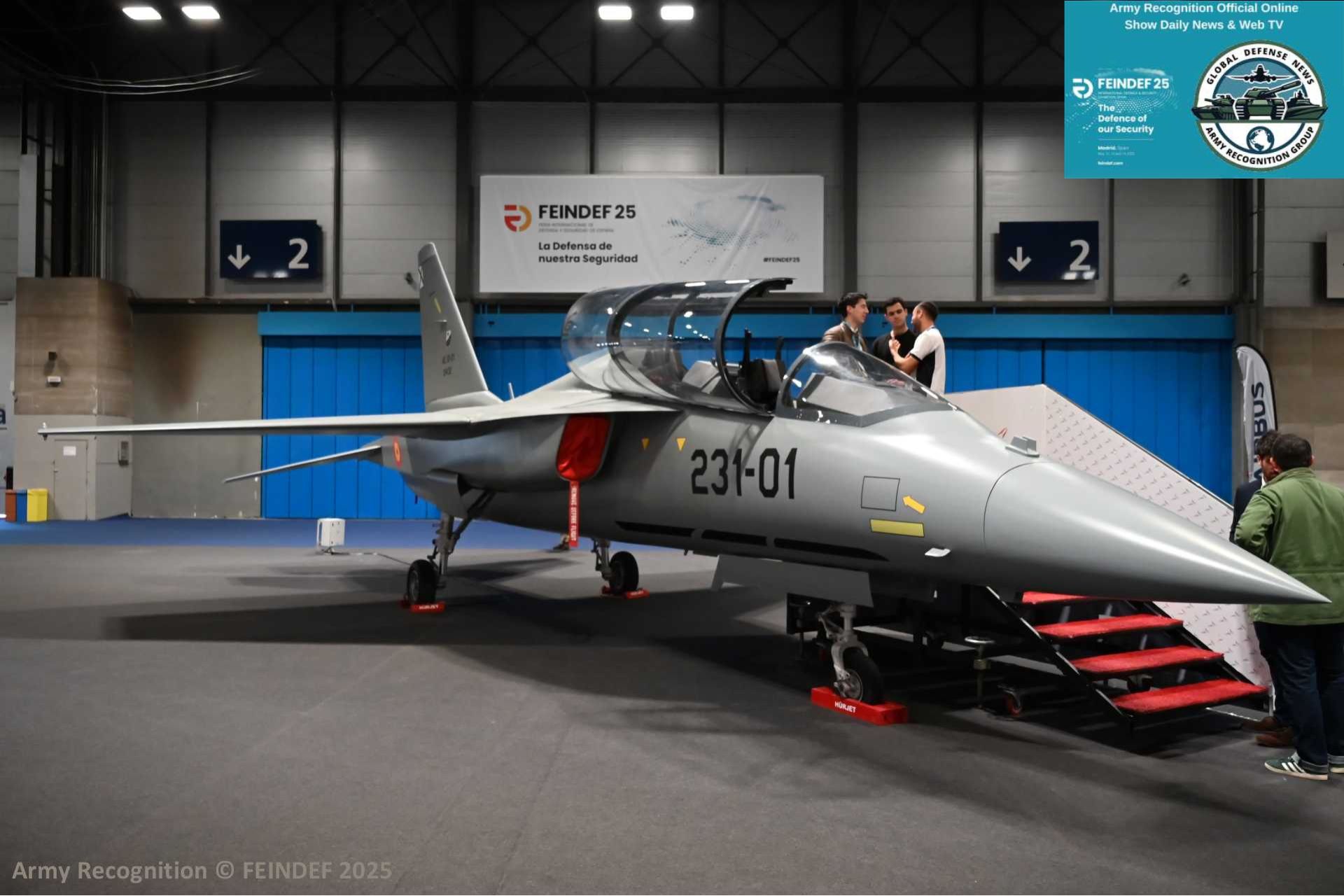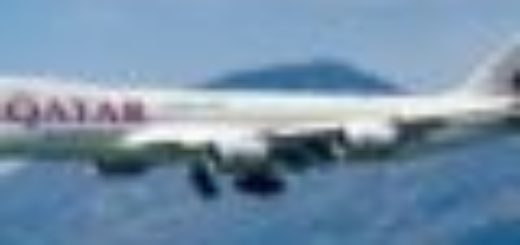FEINDEF 2025: Is Spain Preparing to Replace Its SF-5M with the Turkish Hürjet Trainer Aircraft?

{loadposition bannertop}
{loadposition sidebarpub}
Turkish Aerospace Industries (TUSAŞ) is taking a significant step in its export strategy by presenting a full-scale mock-up of its Hürjet trainer and light combat aircraft at the FEINDEF 2025 exhibition, held from May 12 to 14 in Madrid. This is the first time the aircraft is displayed with Spanish Air Force markings. The presentation comes at a key moment in the growing defense cooperation between Turkey and Spain, a few months after the signing of a Memorandum of Understanding (MoU) in December 2024 regarding a potential Spanish order of 12 to 24 aircraft.
Follow Army Recognition on Google News at this link
Formally launched in August 2017, the Hürjet is a supersonic, single-engine, tandem-seat aircraft developed to meet the training needs of Turkish fighter pilots, while also being capable of performing various operational missions (Picture source: Army recognition)
The mock-up features a grey low-visibility livery with the Spanish roundel near the tail and the designation “231-01” below the canopy—likely referencing the 231 Escuadrón, a training unit within Ala 23 at Talavera La Real Air Base, which currently operates 19 Northrop SF-5Ms.
This symbolic staging of the Hürjet in Spanish colors fits within an advanced selection process launched in 2023 to replace the aging SF-5Ms (designated AE.9 by the Spanish Ministry of Defense), which entered service in the 1970s and have undergone two modernization phases. These aircraft are used for advanced training of future Eurofighter Typhoon and F-18M Hornet pilots and are expected to remain in service until 2030, following a life extension program contracted to the Israeli company IAI. However, the increasing obsolescence of the platform is prompting Spain to seek a replacement. The Hürjet, which was demonstrated at Torrejón de Ardoz Air Base between July and August 2024, has emerged as a leading candidate, competing with established platforms like the Boeing T-7 Red Hawk, the Leonardo M-346, and the KAI T-50/FA-50.
Formally launched in August 2017, the Hürjet is a supersonic, single-engine, tandem-seat aircraft developed to meet the training needs of Turkish fighter pilots, while also being capable of performing various operational missions. The aircraft made its first flight on April 25, 2023, and had surpassed 100 test flights by mid-2024. It is capable of reaching Mach 1.4 at a maximum altitude of 45,000 feet, with a range of 2,200 kilometers and a payload capacity of 2,700 kilograms spread over seven hardpoints. TAI highlights advanced flight characteristics, including a full-authority digital fly-by-wire control system, a fully digital NVIS-compatible glass cockpit, a head-up display (HUD), helmet-mounted display (HMD), in-flight refueling capability, and an auxiliary power unit (APU) for ground autonomy. The Hürjet can also integrate embedded tactical simulation modules and connect to Live Virtual Constructive (LVC) training networks, making it a comprehensive platform for training and operational readiness.
Its planned weapons configuration further supports its multirole capability: it will be able to carry the Turkish-developed Bozdoğan (within-visual-range) and Gökdoğan (beyond-visual-range) air-to-air missiles, as well as a range of precision-guided munitions such as the SOM cruise missile, the Sarb-83 concrete-penetrating bomb, and Teber and KGK guidance kits. The latest prototype, unveiled in late 2024, includes visible design modifications such as a new radome, altered air intakes, and wingtip missile rails, pointing to an enhanced role in light strike, interception, and close air support missions.
On the industrial side, Turkey and Spain have already laid the groundwork for long-term cooperation. TUSAŞ has signed an agreement with the Spanish company Airtificial to manufacture 31 flight control systems for future Hürjet aircraft. In parallel, a partnership between TAI, GE Aerospace, and Turkish Engine Industries (TEI) provides for the local assembly and maintenance of the F404-GE-102 turbofan engine selected for the aircraft. This industrial collaboration aims to ensure partial autonomy for maintenance in Spain while also strengthening bilateral supply chain integration. This dimension could be a decisive factor for the Spanish Ministry of Defense, especially in comparison with competitor offers that may lack similar local industrial benefits.
According to InfoDefensa, the Spanish Air Force is considering the purchase of 28 to 30 aircraft under a program budgeted at €275 million. While no official decision has been made, the presence of TAI CEO Mehmet Demiroğlu at FEINDEF 2025 suggests that announcements may be forthcoming. The fact that the Chief of Staff of the Spanish Air Force, General Francisco Braco, has personally flown in the Hürjet further reflects the concrete interest in the platform.
By exhibiting a mock-up in Spanish livery at the country’s main defense event, Turkey is not only pursuing a strategic export opportunity but also aiming to affirm its growing role in the European defense aerospace market. Should Spain confirm the acquisition, it would mark a significant shift in the diversification of its military procurement sources and signal a move toward industrial partnerships beyond the traditional transatlantic sphere. For Ankara, it would represent the culmination of years of investment into a program designed to position the Hürjet as a credible alternative to Western platforms for both training and light combat missions.
In this context, the Hürjet stands as more than just an aircraft—it is a symbol of industrial diplomacy and strategic projection. Its presentation at FEINDEF 2025 in Spanish markings offers a visual confirmation of Turkey’s ambition to become a recognized supplier within the European military aviation sector.

{loadposition bannertop}
{loadposition sidebarpub}
Turkish Aerospace Industries (TUSAŞ) is taking a significant step in its export strategy by presenting a full-scale mock-up of its Hürjet trainer and light combat aircraft at the FEINDEF 2025 exhibition, held from May 12 to 14 in Madrid. This is the first time the aircraft is displayed with Spanish Air Force markings. The presentation comes at a key moment in the growing defense cooperation between Turkey and Spain, a few months after the signing of a Memorandum of Understanding (MoU) in December 2024 regarding a potential Spanish order of 12 to 24 aircraft.
Formally launched in August 2017, the Hürjet is a supersonic, single-engine, tandem-seat aircraft developed to meet the training needs of Turkish fighter pilots, while also being capable of performing
various operational missions (Picture source: Army recognition)
The mock-up features a grey low-visibility livery with the Spanish roundel near the tail and the designation “231-01″ below the canopy—likely referencing the 231 Escuadrón, a training unit within Ala 23 at Talavera La Real Air Base, which currently operates 19 Northrop SF-5Ms.
This symbolic staging of the Hürjet in Spanish colors fits within an advanced selection process launched in 2023 to replace the aging SF-5Ms (designated AE.9 by the Spanish Ministry of Defense), which entered service in the 1970s and have undergone two modernization phases. These aircraft are used for advanced training of future Eurofighter Typhoon and F-18M Hornet pilots and are expected to remain in service until 2030, following a life extension program contracted to the Israeli company IAI. However, the increasing obsolescence of the platform is prompting Spain to seek a replacement. The Hürjet, which was demonstrated at Torrejón de Ardoz Air Base between July and August 2024, has emerged as a leading candidate, competing with established platforms like the Boeing T-7 Red Hawk, the Leonardo M-346, and the KAI T-50/FA-50.
Formally launched in August 2017, the Hürjet is a supersonic, single-engine, tandem-seat aircraft developed to meet the training needs of Turkish fighter pilots, while also being capable of performing various operational missions. The aircraft made its first flight on April 25, 2023, and had surpassed 100 test flights by mid-2024. It is capable of reaching Mach 1.4 at a maximum altitude of 45,000 feet, with a range of 2,200 kilometers and a payload capacity of 2,700 kilograms spread over seven hardpoints. TAI highlights advanced flight characteristics, including a full-authority digital fly-by-wire control system, a fully digital NVIS-compatible glass cockpit, a head-up display (HUD), helmet-mounted display (HMD), in-flight refueling capability, and an auxiliary power unit (APU) for ground autonomy. The Hürjet can also integrate embedded tactical simulation modules and connect to Live Virtual Constructive (LVC) training networks, making it a comprehensive platform for training and operational readiness.
Its planned weapons configuration further supports its multirole capability: it will be able to carry the Turkish-developed Bozdoğan (within-visual-range) and Gökdoğan (beyond-visual-range) air-to-air missiles, as well as a range of precision-guided munitions such as the SOM cruise missile, the Sarb-83 concrete-penetrating bomb, and Teber and KGK guidance kits. The latest prototype, unveiled in late 2024, includes visible design modifications such as a new radome, altered air intakes, and wingtip missile rails, pointing to an enhanced role in light strike, interception, and close air support missions.
On the industrial side, Turkey and Spain have already laid the groundwork for long-term cooperation. TUSAŞ has signed an agreement with the Spanish company Airtificial to manufacture 31 flight control systems for future Hürjet aircraft. In parallel, a partnership between TAI, GE Aerospace, and Turkish Engine Industries (TEI) provides for the local assembly and maintenance of the F404-GE-102 turbofan engine selected for the aircraft. This industrial collaboration aims to ensure partial autonomy for maintenance in Spain while also strengthening bilateral supply chain integration. This dimension could be a decisive factor for the Spanish Ministry of Defense, especially in comparison with competitor offers that may lack similar local industrial benefits.
According to InfoDefensa, the Spanish Air Force is considering the purchase of 28 to 30 aircraft under a program budgeted at €275 million. While no official decision has been made, the presence of TAI CEO Mehmet Demiroğlu at FEINDEF 2025 suggests that announcements may be forthcoming. The fact that the Chief of Staff of the Spanish Air Force, General Francisco Braco, has personally flown in the Hürjet further reflects the concrete interest in the platform.
By exhibiting a mock-up in Spanish livery at the country’s main defense event, Turkey is not only pursuing a strategic export opportunity but also aiming to affirm its growing role in the European defense aerospace market. Should Spain confirm the acquisition, it would mark a significant shift in the diversification of its military procurement sources and signal a move toward industrial partnerships beyond the traditional transatlantic sphere. For Ankara, it would represent the culmination of years of investment into a program designed to position the Hürjet as a credible alternative to Western platforms for both training and light combat missions.
In this context, the Hürjet stands as more than just an aircraft—it is a symbol of industrial diplomacy and strategic projection. Its presentation at FEINDEF 2025 in Spanish markings offers a visual confirmation of Turkey’s ambition to become a recognized supplier within the European military aviation sector.






